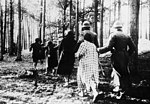Raid on Truskaw
The Raid on Truskaw was a surprising attack on the battalion stationed in the village of Truskaw by the Kaminski Brigade, carried out on the night of 2/3 September 1944 by a detachment from the Kampinos Group led by Lieutenant Adolf Pilch, codenamed Dolina. On 27 August 1944, the vicinity of Truskaw and Sieraków was occupied by units of the collaborating Kaminski Brigade, thus preventing communication between Home Army units in the Kampinos Forest and the insurgent Warsaw. The enemy soon began to attack the Polish outpost in nearby Pociecha. In this situation, commanding the "Palmiry-Młociny" Regiment, Lieutenant Dolina organized a night raid on the Kaminski troops stationed in Truskaw. With minimal losses of their own, the Poles completely defeated two enemy subunits, capturing large quantities of weapons and ammunition in the process. This success – combined with a successful Raid on Marianów the following night – forced the Kaminski Brigade to retreat from the southern outskirts of the Kampinos Forest.
Excerpt from the Wikipedia article Raid on Truskaw (License: CC BY-SA 3.0, Authors).Raid on Truskaw
3 Maja, gmina Izabelin
Geographical coordinates (GPS) Address Nearby Places Show on map
Geographical coordinates (GPS)
| Latitude | Longitude |
|---|---|
| N 52.307222222222 ° | E 20.7675 ° |
Address
3 Maja 203
05-080 gmina Izabelin
Masovian Voivodeship, Poland
Open on Google Maps




